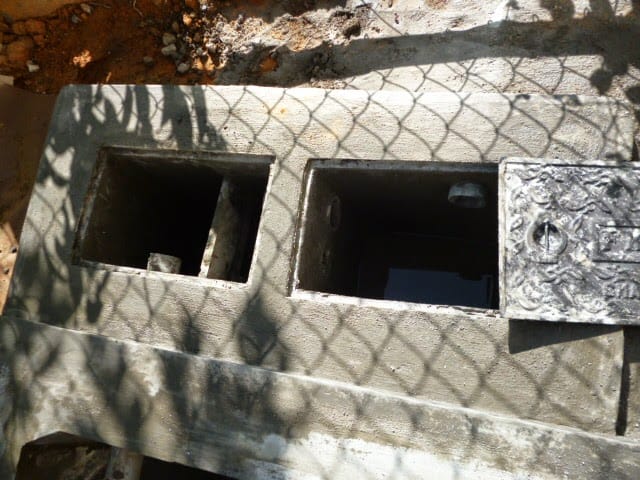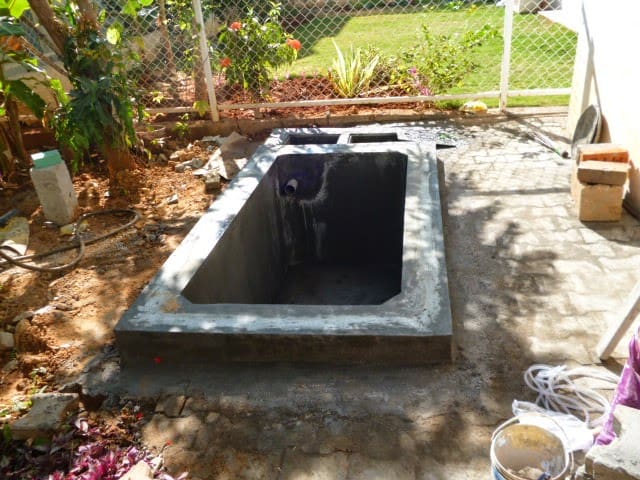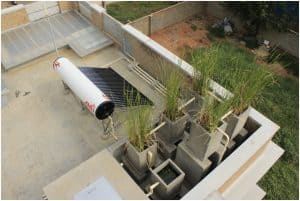This summer, Bengalureans faced another gruelling water crisis. So much so that residents even in core areas of the city had to start buying water from private tankers. And in outer areas, even private tanker supply was inadequate.
We had earlier published a guide on building recharge wells to capture rainwater this monsoon. Another way to meet your water requirement is by treating and reusing the greywater generated in your household, especially if you live in an independent house.
What is greywater?
Greywater is simply soap water; it’s the wastewater from bathrooms, washing machines etc. Greywater does not contain much organic matter, and the major contaminant in it is phosphates from soap. In contrast, blackwater – which is mainly wastewater from the toilet and kitchen – contains organic matter and pathogens.
Since greywater has fewer pathogens, it is easier to treat and reuse, especially at a domestic scale. On average, a four-member household generates 360 litres of greywater daily.
Why treat greywater?
- About 40 percent of the wastewater generated in your home is greywater. If treated, it can be reused for toilet-flushing, car wash and gardening, and can meet upto 40 percent of your household’s water requirement. That is, reusing treated greywater will significantly reduce your freshwater requirement.
- Greywater from households usually enters the city’s sewerage system, along with blackwater. When you separate greywater and treat it, you are also reducing the amount of sewage that ends up polluting the city’s lakes and drains
- Only 50-75 sq ft area is required to set up the treatment system in your plot. Water moves through the system by gravity, and does not have to be pumped
| Ravi Iyer and Mahalakshmi Jayaram have greywater treatment systems in their homes. Iyer has a thriving garden, fed by treated greywater; he does not use freshwater for gardening anymore. Mahalakshmi has a rainwater harvesting system in addition to her greywater treatment system. Together, these systems ensure that her household is nearly independent when it comes to water. |
How to set up a greywater treatment facility?
There are different methods to treat greywater. The one discussed here is a natural treatment system that uses a reed bed. You can set it up either on the rooftop or in the plot around your house. Consult a professional to decide on the specifications and location of the system.
The main components of the system are:
- Grease trap
- Baffle filter
- Reed bed
- Storage tank
How is water purified in the system?
- Pipes are installed to carry carry greywater from multiple sources like bathrooms and washing machine, to the grease trap. Sometimes kitchen water is also treated, though it has high organic content. You should have separate pipe networks for greywater and blackwater to ensure that they don’t get mixed. In the grease trap, large solids would get separated and float over the water. A baffle wall ensures that these solids do not flow further through the system, and that only water enters the baffle filter.

Grease trap. Pic: Biome Trust
- The baffle filter comprises a filter and several baffle chambers. When water flows through these chambers, it is treated by anaerobic decomposition which removes any small solids remaining in the water or impurities floating over it.
- From the baffle chambers, water flows into the reed bed. Reed bed is simply a tank filled with gravel, in which wetland plants are grown. The bed should have depth of 1-1.5 m and area of 5-7 sq m for every 1000 litres of water treated. Reeds grow using water and nutrients alone; hence they can absorb nutrients, including those in soap. Pathogens in the water are also destroyed in the reed bed – these may die naturally, by antibiotics released from roots, UV exposure, sedimentation, and on sticking to the gravel bed.

Reed bed under construction. Pic: Biome Trust
- Treated water from the reed bed flows into an open storage tank. Here the water will become more oxidised, which can also oxidise any remaining pollutants. Odour of the water reduces, and any remaining pathogen is destroyed by UV exposure. This treated water is ready for use! It should ideally be used up within a day. If fish is also bred in the tank, much of the nitrogen and phosphorous content would be removed, but this is not a requirement. Wastewater from RO systems can also be routed into the storage tank, after passing it through a chamber where sediments can settle. Size of the tank should depend on your usage of the treated water.
Here’s a video explaining the treatment system in a plot. If you install the system on the rooftop, the treated water can be used for terrace gardening. Here is an example of a rooftop system that is used to grow rice on the terrace.

A rooftop greywater treatment system. The reeds can be grown in barrels too. Pic: urbanwaters.in
How much do they cost?
Setting up the system in a plot cost Rs 50,000 – Rs 1,75,000, as of early 2017.
Keep in mind
- Use natural soaps and detergents as far as possible
- Clean the baffle filter every 5-8 years. It should have a vent, and also an access point to allow for maintenance
- Both the reed bed and storage tank should be built in a sunlit area
- Trim the plants in the reed bed from time to time
- Clean the storage tank when required
- Walls of the reed bed should be eight inches above ground level, to prevent surface water runoff from entering it
- Breed guppy fish in the storage tank, or cover it with a mosquito mesh, to prevent mosquito breeding in the treated water
Find more details on setting up the system here.
[This guide is based on material originally published by Biome at the Urban Waters website]
If I have understood this correctly, waste water from washing machine, water from face wash basins and bath area in bath rooms can all be mixed and treated this way.
Water from kitchen sink and cooking vessels wash area can not be mixed.
I will be thankful if a reply is given here, or to my via my given e mail
No need to confirm that I am from water defeated/starved Madras/Chennai
Yes, Mr Sankar, your assumptions are right. But this method requres quite a large area of open space in your plot. In the present scenario, this may be feasible only in gated complexes, with adequate open area.
Hello Mr Rajagopalan, the treatment system does not require much area – only 50-75 sq ft is needed. This system is particularly useful for independent houses.
Mr Sankarasubramanian, yes, water from wash basins, bathrooms and washing machines are commonly treated in this system.
– Ed
Hi, I don’t understand why water from kitchen tap cannot be treated as grey water? We also have a dishwasher which also generates grey water